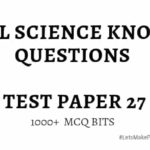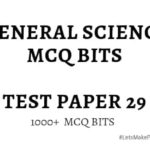NCERT MCQ Bit Bank Series
General Science MCQ Questions For Competitive exams
Test Paper 28
Learn General science NCERT MCQ Questions
1. Real Images is
a) Inverted
b) Erect
c) Upright
d) None
a) Inverted
2. Virtual Image is
a) Inverted
b) Erect
c) Upright
d) B and C
d) B and C
3. Lens used for Real image are
a) Converging Lens
b) Diverging Lens
c) Both
d) None
a) Converging Lens
4. Lens used for Virtual image are
a) Converging Lens
b) Diverging Lens
c) Both
d) None
b) Diverging Lens
5. Mirrors used for Real images ?
a) Concave Mirror
b) Convex Mirror
c) Plane Mirror
d) All the above
a) Concave Mirror
6. Mirrors used for Virtual images ?
a) Concave Mirror
b) Convex Mirror
c) Plane Mirror
d) All the above
d) All the above
7. Real image is formed when the light rays meet at a particular point ?
a) Before reflection the mirror
b) After reflection from the mirror
c) Both
d) None
b) After reflection from the mirror
8. Virtual image is formed when the light rays meet at definite point ?
a) Before reflection the mirror
b) After reflection from the mirror
c) Both
d) None
b) After reflection from the mirror
9. Examining of eyes, ears and nose, which of the following is used ?
a) Convex Mirror
b) Concave Mirror
c) Plane Mirror
d) All the above
b) Concave Mirror
10. Which of following mirrors are used in scooter/cars as side mirrors ?
a) Concave Mirrors
b) Convex Mirrors
c) Plane Mirror
d) All the above
b) Convex Mirrors
11. Magnifying glasses are ?
a) Concave Lens
b) Convex Lens
c) Plane Mirror
d) All the above
b) Convex Lens
12. Convex lens are ?
a) Converging Lens
b) Diverging Lens
c) Both
d) None
a) Converging Lens
13. Concave lens are ?
a) Converging Lens
b) Diverging Lens
c) Both
d) None
b) Diverging Lens
14. Image formed by Concave lens are ?
a) Virtual
b) Erect
c) Smaller in size
d) All the above
d) All the above
15. Images can be obtained on a screen is called ?
a) Virtual Image
b) Real Image
c) Erect
d) None
b) Real Image
16. Images cannot be obtained on a screen is called ?
a) Virtual Image
b) Real Image
c) Erect
d) None
a) Virtual Image
17. Image formed from plane mirror is ?
a) Virtual
b) Erect
c) Smaller in size
d) All the above
b) Erect
18. Images formed from Concave mirror ?
a) Virtual
b) Inverted
c) Real
d) B and C
d) B and C
19. White lights is composed of ?
a) Five colours
b) Six colours
c) Seven colours
d) Nine colours
c) Seven colours
20. In Superconductivity, metals resistance becomes ?
a) High
b) Zero
c) 100 ohms
d) -100 ohms
b) Zero
21. Temperature of Superconductivity of Mercury ?
a) -100 degree Celsius
b) -200 degree Celsius
c) -269 degree Celsius
d) -369 degree Celsius
c) -269 degree Celsius
22. To detect nature of charge( Positive charge or negative charge) which of the following device is used ?
a) Electroscope ?
b) Rheostaut
c) Gold Leaf
d) All the above
c) Gold Leaf
Note: Gold leaf is invented by Bennet
23. Moving coil Galvanometer(MCV) is used to measure ?
a) Strength of Voltage
b) Strength of Current
c) Both
d) None
b) Strength of Current
Note: MCV is used to measure upto 10⁻⁹Amp and also to determine direction of flow of current through conductor
24. Potentio meter is used to measure ?
a) Magnitude of emf
b) Internal resistance of cell
c) Both
d) None
c) Both
25. Capacity of capacitor is measured in ?
a) ohm
b) Farad
c) Both
d) None
b) Farad
26. Transformers are used for transmitting power from ?
a) High Voltage to Low Voltage
b) Low Voltage to High Voltage
c) Both
d) None
c) Both
27. Transformer works on the principle of ?
a) Internal Induction
b) Mutual Induction
c) Both
d) None
b) Mutual Induction
Note: Transformer principle proposed by Lenz
28. First transformer was constructed by ?
a) Lenz
b) Micheal Faraday
c) Ohms
d) None
b) Micheal Faraday
29. Cell is invented by ?
a) Michael Faraday
b) Volta
c) Newton
d) None
b) Volta
Note: With his name, we call Volta cells batteries
30. Laws of Electrolysis proposed by ?
a) Michael Faraday
b) Volta
c) Newton
d) None
a) Michael Faraday
32. In Volta cells, Anode(+), Cathode(-) and Electrolyte used are ?
a) Carbon, Zinc and Dil.NH4Cl
b) 2 carbon rods, Zinc and Dil.H2SO4
c) Copper, Zinc and Dil. H2SO4
d) None
c) Copper, Zinc and Dil. H2SO4
33. In Daniel cells, Anode(+), Cathode(-) and Electrolyte used are ?
a) Carbon, Zinc and Dil.NH4Cl
b) 2 carbon rods, Zinc and Dil.H2SO4
c) Copper, Zinc and Dil. H2SO4
d) Copper, Zinc and 2 electrolyte (Copper sulphate and Zinc sulphate)
d) Copper, Zinc and 2 electrolyte (Copper sulphate and Zinc sulphate)
34. In Bichromate cells, Anode(+), Cathode(-) and Electrolyte used are ?
a) Carbon, Zinc and Dil.NH4Cl
b) 2 carbon rods, Zinc and Dil.H2SO4
c) Copper, Zinc and Dil. H2SO4
d) Copper, Zinc and 2 electrolyte (Copper sulphate and Zinc sulphate)
b) 2 carbon rods, Zinc and Dil.H2SO4
35. In Dry cells, Anode(+), Cathode(-) and Electrolyte used are ?
a) Carbon, Zinc and Dil.NH4Cl
b) 2 carbon rods, Zinc and Dil.H2SO4
c) Copper, Zinc and NH4Cl(paste)
d) Copper, Zinc and 2 electrolyte (Copper sulphate and Zinc sulphate)
c) Copper, Zinc and NH4Cl(paste)
36. Chargeable cell are invented by ?
a) Glantr
b) Glante Plaston
c) Edison
d) None
b) Glante Plaston
37. In Chargeable cells ?
a) Electrical energy converted to chemical energy
b) Chemical energy converted to electrical energy
c) Electrical energy converted to chemical energy and further Chemical energy converted to electrical energy
d) None
c) Electrical energy converted to chemical energy and further Chemical energy converted to electrical energy
38. Storage cell are invented by ?
a) Glante
b) Glante Plaston
c) Thomas Alva Edison
d) None
c) Thomas Alva Edison
39. King of chemicals ?
a) Sulphuric acid
b) Nitric Acid
c) Ammonia acid
d) None
a) Sulphuric acid
40. Filament in bulb is made of ?
a) Sliver
b) Steel
c) Ivory
d) Tungsten
d) Tungsten
41. Which of following gas is filled in bulb ?
a) Aron gas
b) Hydrogen gas
c) Nitrogen gas
d) None
a) Aron gas
42. Melting point of Tungsten metal is ?
a) 100 degree Celsius
b) 1000 degree Celsius
c) 2400 degree Celsius
d) None
c) 2400 degree Celsius
43. Which of following is correct for CFL Bulb?
a) Compact fluorescent light
b) Compond fluorescent light
c) Compact fluores light
d) Compact fluorescent liquid
a) Compact fluorescent light
44. To emit white colour light which of the following vapor is filled ?
a) Sodium Vapor
b) Mercury Vapor
c) Aron Vapor
d) Neon
b) Mercury Vapor
45. To emit Yellow colour light which of the following vapor is filled ?
a) Sodium Vapor
b) Mercury Vapor
c) Aron Vapor
d) Neon
a) Sodium Vapor
Learn More
Link 1 – Physics | Biology | Indian History | T-History MCQ Questions Test papers
Link 2 – Buy/Downlaod Physics MCQ Bit Bank eBook
Link 3 – Free eBooks For Competitive Exams
Link 4 – Top Books for Competitive Exams
Link 5 – Download Quantitative and Aptitude Competitive Exams
For Complete GK/GS – Click Here
#LetsMakePreparingForGovtJobsEasy
Related search
Ncert online learning, ncert e learning, ncert bits for exams, ncert ecopy notes, ncert class 7 material, ncert imp mcq bits, ncert bits mcq questions, ncert bits mcq questions and answers, ncert bits mcq question answers, class 7 ncert bits mcq, grade 7 ncert mcq bits, grade 7 ncert material online, grade 7 GK e learning, ncert online e-learning, ncert e-learning, ncert mcq question answers, ncert bits online, ncert bits for competitive exams, ncert bits for exams, ncert bits for ssc, ncert ssc exams material, ncert ssc mcq questions, ncert ssc mcq bits online, ncert bits mcq questions answer, learn ncert bits mcq questions online, tspsc ncert bits mcq questions, ssc notes for ncert bits mcq questions

